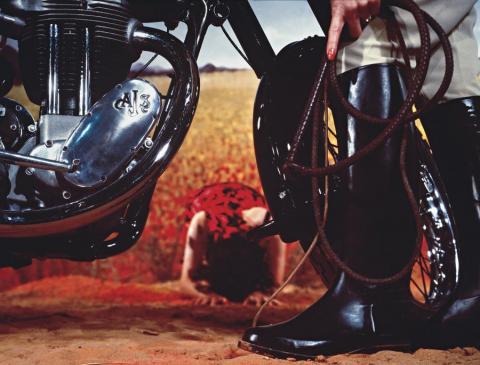SOMETHING MORE NO. 8, 1989
TRACEY MOFFATT
cibachrome photograph
94.5 x 125.5 cm
edition: 24/30
signed, dated and numbered verso: T. MOFFATT '89 24/30
Christie’s, New York, 16 November 2001, lot 503
Private collection, Melbourne
Sotheby’s, Sydney, 22 April 2008, lot 76
Private collection, Melbourne
It is impossible to conceive of contemporary Australian photography without the work of Tracey Moffatt, and indeed the lush imagery of her Something More series. Originally exhibited in 1989 as part of Moffatt’s first solo exhibition, held at the Australian Centre for Photography, Sydney, the series has since become embedded in the lexicon of urban Indigenous art practice. As noted by curator Gael Newton ‘Something More instantly established Moffatt’s presence... and its surreal and exaggerated spaces became her signature style.’1
Without doubt one of the most beautiful and caustic in the series, Something More No 8 encourages certain finite cultural readings regarding subjugation and the inherent sadomasochism of colonialism. The prostrate figure, played by the artist herself, presses her hands into the red dust whilst an unknown female presents us with a stock whip, glossy as a serpent against the black sheen of her boots. The image succinctly highlights Moffatt’s ability to draw inspiration from high art as well as mass entertainment. Firmly embedded within the structure and stylistic language of television, film and media culture, much of the artists’ work is based upon recollections from ‘a whole 1960s childhood and 1970s adolescence (spent) glued to the television or with my nose in a book.’2
Moffatt’s work moves well beyond the retrospections of an introverted youth. Her complex fragmentations of the narrative arc, so deftly executed in Something More, leave the viewer to wonder at the unexplained ‘in between’ events which populate her work. The allegory presented here is strangely recognisable; half memory, half apparition. As Moffatt plays to the anticipation that is generated between desire and fulfilment, she provides both release and succour through the sheer beauty of her work, though ‘it is a pleasure always attended by a feeling of unease.’3
1. Newton, G., Tracey Moffatt, Invocations, The Australian National University, 2001, p. 12
2. The artist quoted in Photography, Art Gallery of New South Wales Collection, Art Gallery of New South Wales, Sydney, 2007, p. 262
3. Wallace, M., ‘Tracey Moffatt’s visual pleasures’, in Brought to Light II, Contemporary Australian Art 1966-2006 from the Queensland Art Gallery Collection, Queensland Art Gallery Publishing, Brisbane, 2007, p. 309
MERRYN SCHRIEVER
